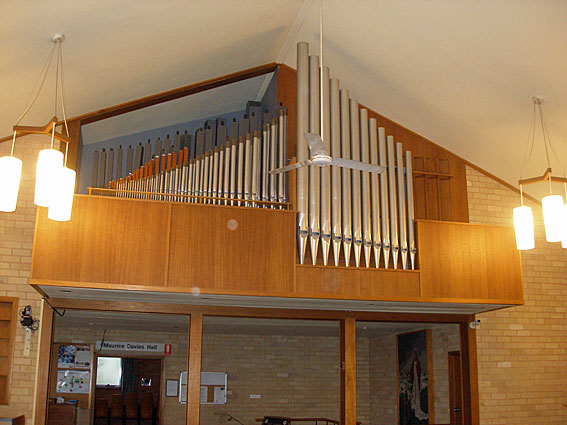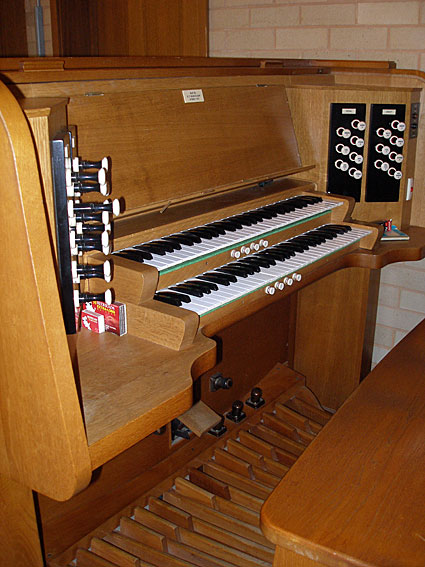Methodist Church, North Sydney and elsewhere.
2m., 8 rks, + mixture ext., 5c., el. mag.
Gt: 8.8.8.4.4.2-2/3.2. Sw: 8.8.4.4.2.1-1/3.III.8. Ped: 16.8.5-1/3.4.4.8.4.


From the Sydney Organ Journal, Spring 2011:
The final organ to be visited during the Society's June ramble was the 1971 S.T. Noad & Son organ in the West Epping Uniting Church. Details of this organ have never appeared in The Sydney Organ Journal and so it seems to be appropriate to provide these here. Information on the history of the organ was originally supplied to me over 30 years ago by the Ken Noad, at interview in Canberra on 22 January 1980.
When the Methodists in West Epping were considering an organ for their new building fronting Carlingford Road, they decided to purchase and install the small 1885 W.E. Richardson tracker organ from the North Sydney Methodist Church. This church, in Walker Street, was resumed as a part of commercial redevelopment near North Sydney railway station around 1970 and thus the organ became redundant. It was removed by S.T. Noad & Son to storage at their factory in Carnarvon Street, Auburn (Silverwater).
While the history of the North Sydney organ and buildings is contained in Graeme Rushworth's Historic Organs of New South Wales (Sydney: Hale & Iremonger, 1988), page 327, Rushworth does not record its specification, so it is reproduced below. (The sources are "New Pipe Organ", The Weekly Advocate, 27 February 1886, page 387 and The Sydney Morning Herald, 19 January 1886, page 7).
| Great Open Diapason Stopped Diapason & Clarabella Principal Swell Spitz Flute Gamba Lieblich Flute Pedal Bourdon |
8 8 4 8 8 4 16 |
Three couplers, Pitch Pine case. Compass 56/30
When the factory of S.T. Noad & Son was gutted by fire shortly after the death of Sidney Noad on 21 October 1971, much of the W.E. Richardson organ was lost. Thankfully the West Epping Church had adequate insurance and it was thus possible to use a generous settlement to order a completely new organ, but one which used some second-hand pipe work. According to Ken Noad, some North Sydney pipe work survived and this was joined by other second-hand pipes from St Alban's Liberal Catholic Cathedral, Regent Street, Chippendale, a building which had been destroyed by fire in 1968. This church (owned by the Methodists up to 1918 and known as Wesley Church) stood on land to the immediate south of the Mortuary Station, which survives as a landmark today. Its organ had been built by Henry Jones of London in 1879, enlarged in 1902 and electrified in 1935 by S.T. Noad.
Exactly what ranks and pipes from these two old organs survive at West Epping has yet to be documented, but it would seem that some of the wooden flutes are from old sources. With new pipes added, the instrument supplied by S.T. Noad & Son had eight extended ranks and a separate (and complete) three-rank mixture. The organ was housed on a platform above the doors at the rear of the church, while the console was placed in the chancel. From the outset the organ was an essential ingredient in supporting strong hymn singing and choral work, a real feature of the West Epping Church. For many years the choir was led by Ken Winney, with organists Cliff and Ruth Budge.
While other rebuilding and relocation projects were undertaken by S.T. Noad & Son in late 1971 and 1972, the West Epping organ was the last "new" instrument assembled by the firm. The instrument contains many components supplied by Kimber-Allen of the UK (including the console, switching system and electro-magnets) and shortly after its completion its maintenance was taken over by Pitchford & Garside. This latter firm replaced the Cornopean rank in the 1980s. It is fair to say that careful regulation by Ted Pitchford & Stuart Garside over the years has provided the church with an instrument that is quite successful in tonal terms, and one which has proven very reliable. While some of the derivations (notably the Great Principal 4', extended to 2-2/3' and 2') might seem undesirable from an aesthetic viewpoint, all those who played and heard the instrument last June were quite surprised at how well this organ sounded in what is a typical 1970s suburban Sydney church. Apart from the firm's 1961 organ at Barker College Chapel, this instrument is almost certainly the most musically-pleasing church organ bearing a Noad nameplate. Its specification is:
Great |
8 8 8 4 4 2-2/3 2 8 8 4 4 2 1-1/3 III 8 16 8 5-1/3 4 4 8 4 |
|
Detached drawstop console
Balanced swell pedal
4 pistons per manual
3 toe pistons
Electro-magnetic action
+ Duplicated by toe studs

Photographs: Kelvin Hastie (June 2011)